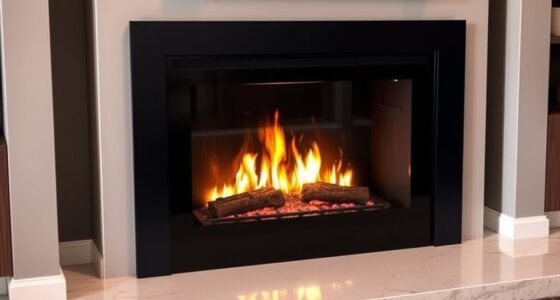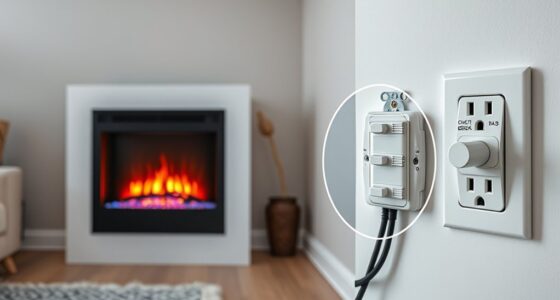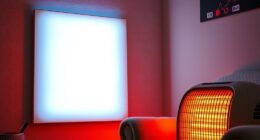Many people mistakenly believe any extension cord can safely power space heaters, ignoring vital safety guidelines and electrical codes. You might overlook the importance of choosing the right gauge, grounding, or environment-specific cords, risking overheating, fires, or shocks. Overloading damaged cords or using multiple cords can compromise safety. Following proper standards and manufacturer instructions is essential, but there’s more to know. Keep going to discover the key safety tips that will protect your home and family.
Key Takeaways
- Not all extension cords are rated for high wattage heaters; selecting the correct gauge and capacity is essential for safety.
- Grounded (three-prong) cords are critical for high-power appliances; using ungrounded cords increases shock and fire risks.
- Overloading cords or daisy-chaining multiple cords can cause overheating and fire hazards, violating electrical codes.
- Outdoor-rated cords should be used outdoors; indoor cords lack weatherproofing and are unsafe for outdoor heater use.
- Regular inspection for damage, frays, or exposed wires is vital; damaged cords should be replaced immediately to prevent fires.
Misconception: Extension Cords Are Safe for Continuous Use With Space Heaters

Many people believe that extension cords are safe to use constantly with space heaters, but this is a dangerous misconception. Extension cord durability varies, and not all cords are built to handle the high power demands of heaters. Using an extension cord with poor durability increases the risk of overheating and electrical failure. Proper electrical grounding is essential for safety, but many extension cords lack adequate grounding features, which can lead to electric shocks or fire hazards. Relying on a flimsy or poorly grounded cord for continuous heater use endangers both your property and your safety. To ensure safe operation, always choose a high-quality extension cord designed for heavy-duty use, with reinforced insulation and proper grounding. Never assume any extension cord is suitable for constant heater operation. Additionally, code compliance is critical to prevent hazards and ensure your setup adheres to safety standards.
Belief That Any Extension Cord Can Handle the Power of Heaters

A common misconception is that any extension cord can handle the power demands of a space heater. In reality, cord length plays a vital role—longer cords can cause voltage drops, reducing safety and efficiency. Many believe that material durability alone determines a cord’s capacity, but cheaper, flimsy cords often lack the necessary insulation and resistance to heat generated by high-wattage devices. Heaters draw significant current, and not all cords are built to withstand that load safely. Using an extension cord that isn’t rated for high power can lead to overheating, melting, or even fires. Always choose cords with appropriate power ratings, considering both cord length and quality of material durability. Ignoring these factors increases risks and violates safety codes. Proper gadget safety and adherence to electrical standards are essential to prevent accidents.
Ignoring the Importance of Proper Cord Gauge for High-Wattage Devices

Since high-wattage devices like space heaters draw substantial current, using an extension cord with the wrong gauge can be dangerous. The gauge importance highlights how wire sizing affects safety and performance. A cord with too thin a wire can’t handle the load, risking overheating and fires. Conversely, a properly gauged cord ensures safe power delivery and reduces hazards. Ignoring wire sizing often leads people to underestimate the danger, assuming any extension cord will suffice. But using an extension cord with an inadequate gauge can cause the cord to heat up, damaging the insulation and increasing the risk of electrical fires. Proper wire gauge selection is essential to match the device’s wattage and current demands, ensuring safety and compliance with electrical codes. Always select a cord with the correct gauge for high-wattage devices to ensure safety, proper function, and compliance with electrical codes.
Overlooking the Need for Grounded or Three-Prong Cords for Safety

Using a grounded or three-prong extension cord is essential for your safety when operating high-wattage devices like space heaters. Grounding requirements are in place to prevent electric shocks and reduce fire risks if a short circuit occurs. The three prong necessity ensures that the cord has a dedicated grounding wire, providing a safe path for stray currents. Ignoring this requirement compromises your safety and may violate electrical codes. Always check that your extension cord has the third prong before plugging in a heater. Using ungrounded cords can lead to dangerous electrical faults, especially when dealing with high power loads. Prioritizing grounded cords not only keeps you safe but also aligns with proper electrical standards for indoor and outdoor heater use. Presence of mold indicates that lemon juice is no longer safe to consume.
Assuming All Extension Cords Are Suitable for Indoor and Outdoor Use
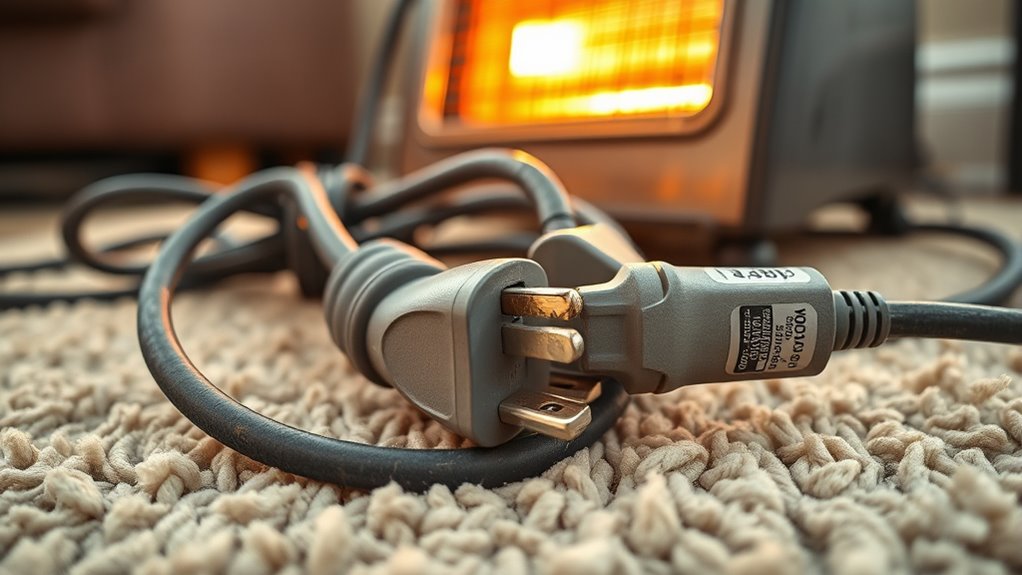
Don’t assume every extension cord is safe for both indoor and outdoor use. Check the labels to see if the cord is rated for your environment, as indoor and outdoor cords have different safety standards. Using the wrong type can increase the risk of electrical hazards or damage. Additionally, selecting a sulfate-free extension cord designed for specific environments can help preserve the cord’s integrity and safety over time.
Indoor vs. Outdoor Ratings
Are all extension cords truly suitable for both indoor and outdoor use? Not necessarily. Indoor ratings and outdoor ratings are designed to address different environments. Indoor-rated cords typically lack the insulation and weatherproofing needed to withstand moisture, dirt, or temperature fluctuations outdoors. Conversely, outdoor-rated extension cords are built with tougher insulation and features to resist these elements, making them safer for outdoor use. Using an indoor-rated cord outside can lead to electrical shorts or fires. Always check the cord’s label or packaging to confirm its ratings. If a cord is marked for outdoor use, it’s suitable for outdoor heaters or other outdoor equipment. Never assume a cord’s versatility; always match the rating to the environment for safety and compliance. Understanding outdoor ratings helps ensure proper protection against weather-related hazards and prevents potential safety issues.
Proper Extension Cord Labels
Extension cords come with labels or markings that clearly indicate whether they are suitable for indoor, outdoor, or both environments. These extension cord labels are essential for verifying safety compliance and ensuring you’re using the right cord for your needs. Look for labels that specify the cord’s rating, such as “Indoor Use Only,” “Outdoor Use,” or “Indoor/Outdoor.” Proper labeling helps prevent accidents, electrical hazards, and damage to your equipment. Always check the labels before purchasing or using an extension cord, especially when powering heaters. Using a cord that isn’t properly labeled for your environment can result in safety violations or dangerous conditions. Ensuring the extension cord’s labels match your application is a simple but vital step in maintaining safety compliance. Additionally, being aware of AI security vulnerabilities can inform better safety practices when integrating smart or connected devices with extension cords.
Usage Environment Impact
Since all extension cords are suitable for both indoor and outdoor use, it’s important to contemplate how the environment impacts their performance and safety. Environmental hazards like moisture, dirt, and temperature fluctuations can degrade the cord’s insulation and increase the risk of electrical faults. Outdoor conditions demand durable, weather-resistant cords, but user behavior also plays a vital role; improper use—such as placing cords in water or exposing them to sharp objects—can lead to hazards. Even if a cord is rated for outdoor use, neglecting proper placement or overloading it compromises safety. Always inspect cords regularly and follow manufacturer guidelines to minimize risks caused by environmental hazards and guarantee safe operation in any setting. Proper home maintenance and careful handling can further extend the lifespan and safety of extension cords used in various environments.
Underestimating Fire Risks From Overloaded or Damaged Cords
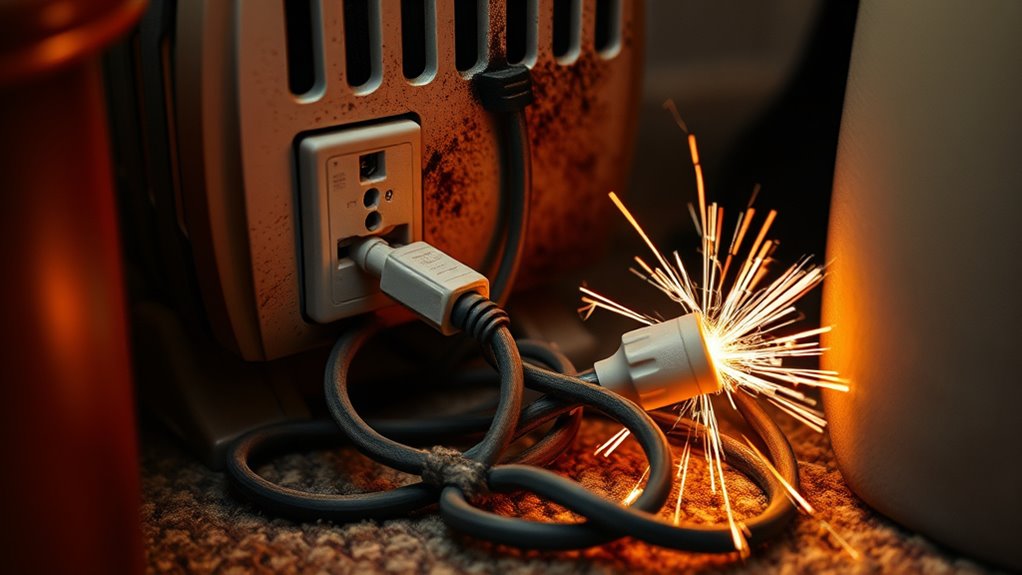
You might think your extension cord can handle multiple devices, but overloading it increases the risk of overheating and fire. Damaged cords with frayed wires or broken insulation are even more dangerous, as they can spark or short circuit unexpectedly. Ignoring these hazards can turn a simple setup into a serious fire danger. Implementing AI security measures can help monitor and detect potential electrical hazards before they cause harm.
Overloading Cords Risks
Overloading cords considerably increases the risk of fire, especially when they are damaged or worn. When you plug in devices that draw more current than the cord’s rated capacity, you bypass overcurrent protection, risking overheating. Overloaded cords can become hot quickly, weakening their cord durability and potentially causing melting or sparks. Never force multiple high-wattage appliances into a single extension cord or exceed its maximum load. Always check the cord’s ampacity and ensure it matches your heater’s power requirements. Using cords with proper overcurrent protection helps prevent dangerous overheating. Remember, a cord’s durability isn’t just about age—it also depends on proper use. Overloading compromises this durability, making it a significant fire hazard you must avoid for safe heater operation. Additionally, damaged cords are especially dangerous, as they are more prone to overheating and should be replaced immediately to ensure safety.
Damage Increases Fire Hazard
Damaged extension cords dramatically increase the risk of fire, especially when combined with overloading. Cord degradation from cuts, frays, or worn insulation weakens the cord’s structure, making it more prone to sparks and electrical shorts. These fire hazards become even greater if you overlook signs of damage and continue using the cord with high-power devices like heaters. Over time, the internal wiring may become exposed or compromised, increasing the chances of overheating. Damaged cords can ignite nearby materials or cause electrical fires, posing serious safety risks. Regularly inspect your extension cords for cracks, burns, or exposed wires. Never ignore damage, and always replace compromised cords to reduce fire hazards and ensure safe heater operation.
Confusing Power Ratings and Not Matching Cord Capacity With Heater Requirements

Misunderstanding power ratings can lead to dangerous situations when selecting extension cords for heaters. Power rating mismatches and cord capacity issues can cause overheating or electrical failures. To avoid these hazards, consider the following:
- Always check the heater’s wattage and amperage before choosing an extension cord.
- Match the cord’s capacity to the heater’s requirements—using a cord with a lower rating can cause overheating.
- Don’t rely solely on general power ratings; verify the cord’s maximum current capacity.
- Remember that longer cords may need higher gauge numbers to handle the load safely.
Failing to Follow Local Electrical Codes and Manufacturer Instructions

Failing to follow local electrical codes and manufacturer instructions can lead to serious safety risks when using heaters with extension cords. Electrical safety is essential, and ignoring proper code compliance can result in fire hazards, electrical shocks, or equipment damage. You must adhere to local building and electrical codes, which specify safe practices for powering heaters. Manufacturer instructions provide vital guidance on proper extension cord use, including cord ratings and placement. Disregarding these instructions increases the risk of overheating, shorts, or electrical failures. Always check that your extension cord and heater meet the required standards and comply with local regulations. Prioritizing code compliance and manufacturer guidelines ensures safe operation, reduces hazards, and protects your home and loved ones from preventable accidents.
Using Multiple Extension Cords or Power Strips to Increase Reach or Power Capacity

Using multiple extension cords or power strips to increase reach or power capacity might seem like a quick fix, but it can pose serious safety hazards. Overloading power strips or cords can cause overheating, risking fires or damage to your heater. To stay safe, remember:
- Never connect multiple power strips or extension cords in a series—this reduces power strip safety.
- Avoid exceeding the combined wattage rating, which can shorten extension cord lifespan.
- Use heavy-duty extension cords designed for high-power appliances like heaters.
- Regularly inspect cords and power strips for damage or wear, replacing them promptly.
Ignoring these guidelines can lead to overheating, electrical failure, or fire. Prioritize proper wiring practices to ensure your heater operates safely without compromising extension cord safety or damaging your equipment.
Frequently Asked Questions
Can Extension Cords Be Safely Used Outdoors With Space Heaters?
You shouldn’t use extension cords outdoors with space heaters, as it risks indoor safety and can lead to electrical hazards. Always plug your heater directly into a grounded outlet and avoid cord storage that could cause damage or overheating. Using outdoor-rated cords designed for weather resistance is safer, but for maximum safety, keep heaters indoors or on approved outdoor power sources to prevent fire risks and comply with safety codes.
What Are the Specific Gauge Requirements for High-Wattage Heaters?
For high-wattage heaters, you should use extension cords with a gauge thickness of at least 14 AWG for wire lengths up to 25 feet, and 12 AWG for longer distances. Thicker gauge wires reduce resistance and prevent overheating. Always match the cord’s gauge to the heater’s power needs and keep wire length as short as possible to guarantee safe operation and prevent electrical hazards.
How Do I Verify if My Extension Cord Meets Local Electrical Codes?
Verifying if your extension cord meets local electrical codes is like reading a map—clear and precise. First, check the cord rating stamped on the insulation for the correct gauge and wattage capacity. Then, look for proper color coding—usually, black or brown indicates a standard rating. Make certain it’s rated for outdoor use if needed. Always compare these details with your local code requirements to stay safe and compliant.
Is It Safe to Connect Multiple Extension Cords for a Single Heater?
You shouldn’t connect multiple extension cords to power a single heater, as it risks extension cord overload and creates a fire hazard. Multiple connections can lead to overheating and damage your cords or heater. To stay safe, plug your heater directly into a properly grounded wall outlet and avoid daisy-chaining cords. Always follow manufacturer instructions and local electrical codes to prevent accidents and guarantee safe operation.
What Signs Indicate an Extension Cord Is Damaged or Overloaded?
Imagine your extension cord whispering warnings — if you notice damaged or frayed cord insulation, it’s time to replace it. Overheating signs like warm spots, melting, or a burnt smell signal danger. Feel for hot or discolored areas along the cord, which indicate overheating. These signs shouldn’t be ignored, as they reveal potential hazards. Always prioritize safety by inspecting your extension cords regularly and replacing damaged ones immediately.
Conclusion
You might think extension cords are a quick fix, but neglecting proper safety can lead to accidents just when you least expect it. Coincidentally, many overlook the importance of matching cords to your heater’s power needs or following local codes, risking fire or injury. Stay cautious, double-check your cords, and prioritize safety—because a small oversight today could prevent a big disaster tomorrow. Your safety truly depends on paying attention to these details.



